Copyright © 2004 South-Western 66 Supply, Demand, and
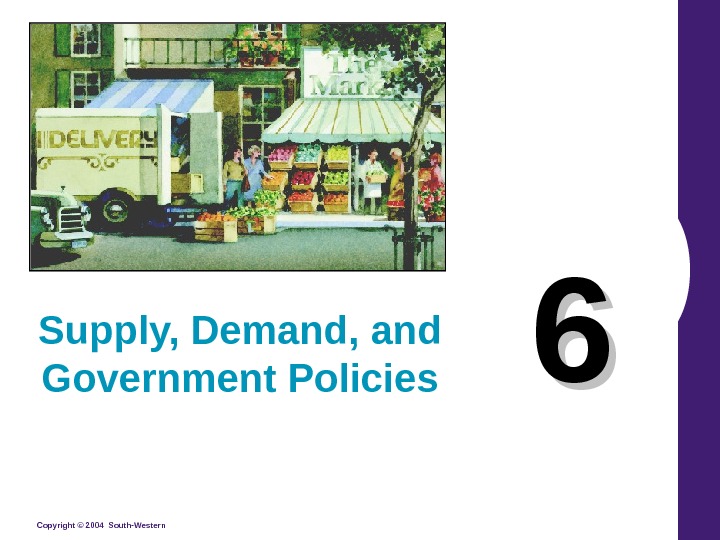
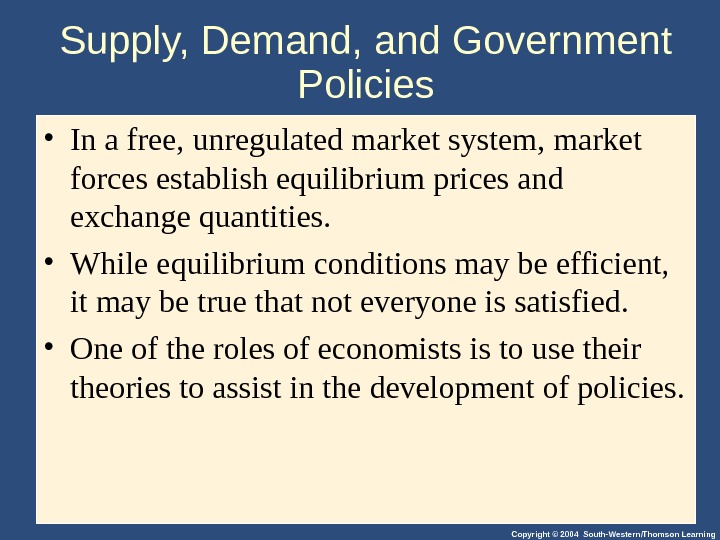


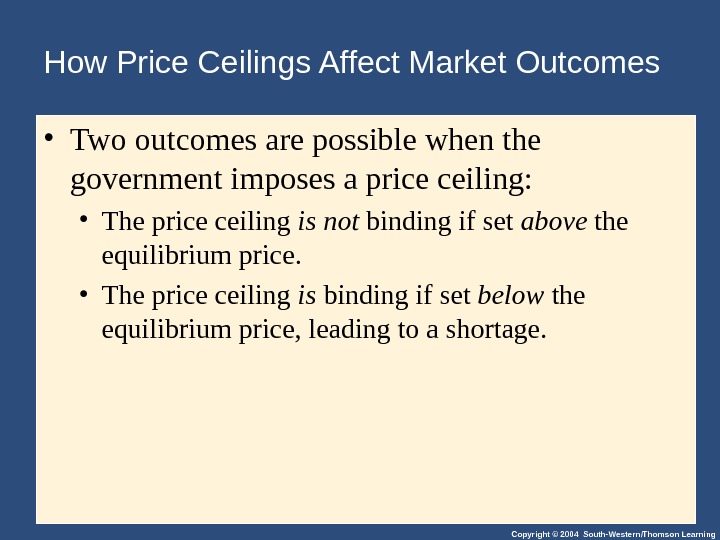
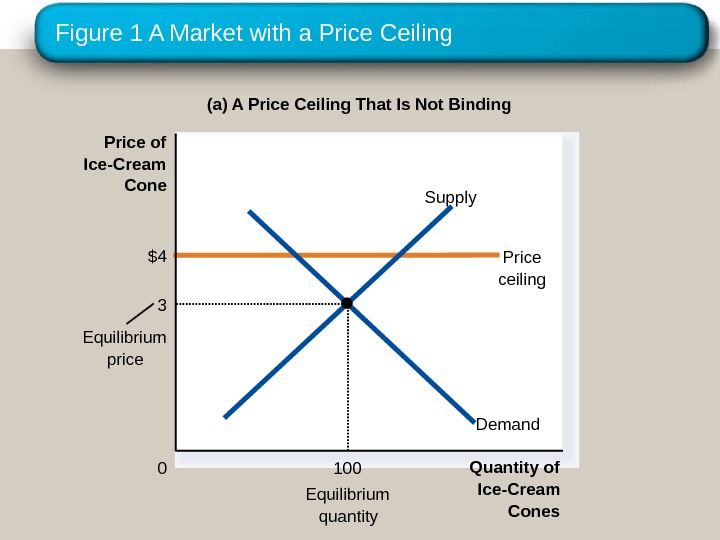
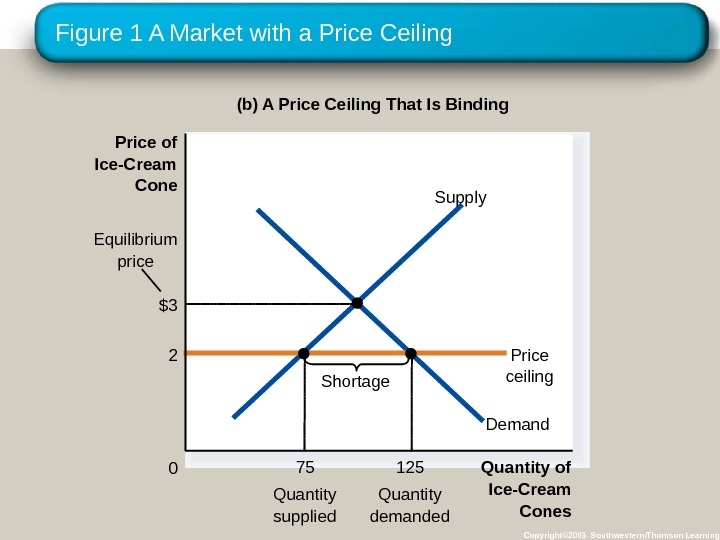
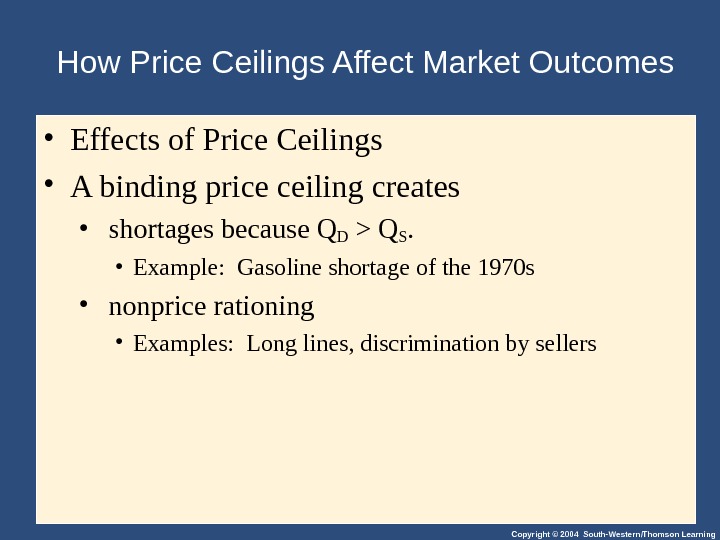

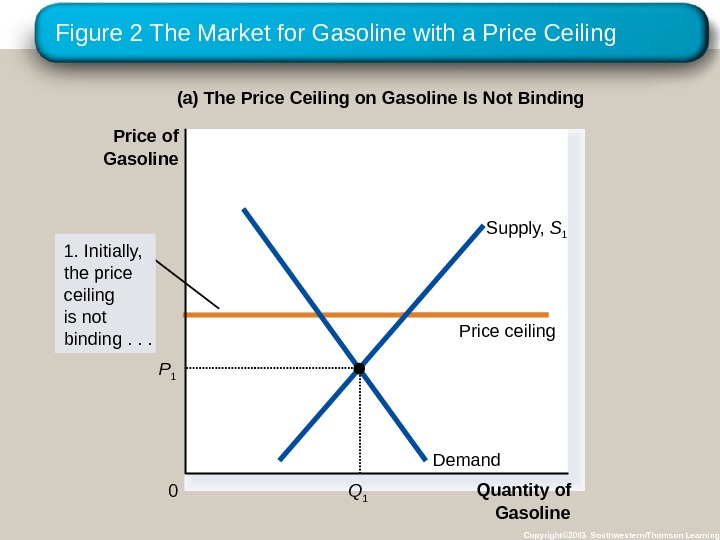
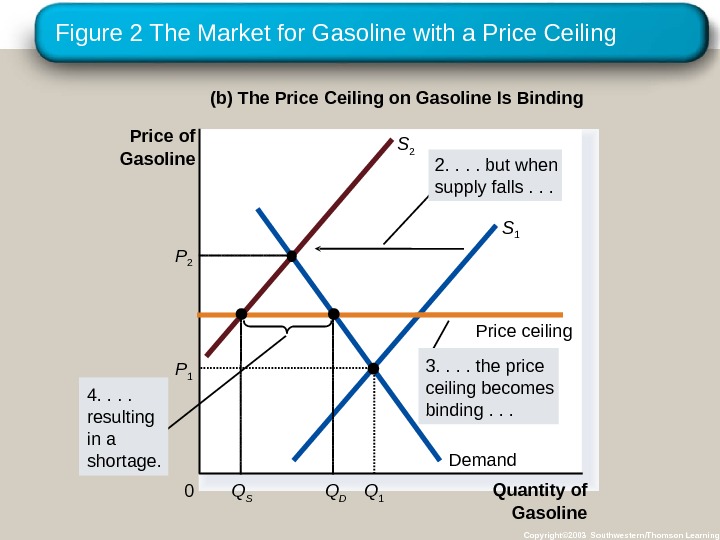
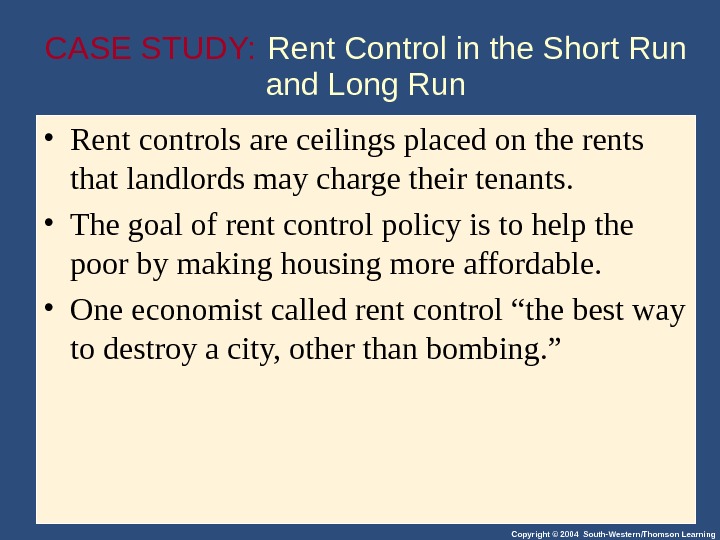




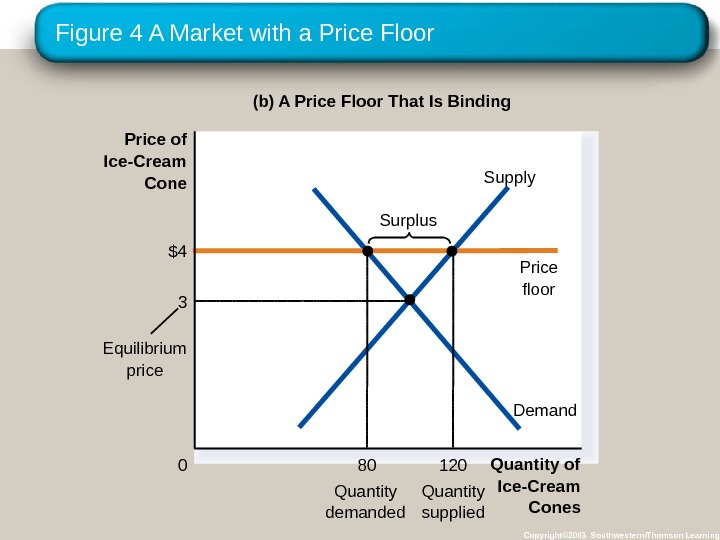

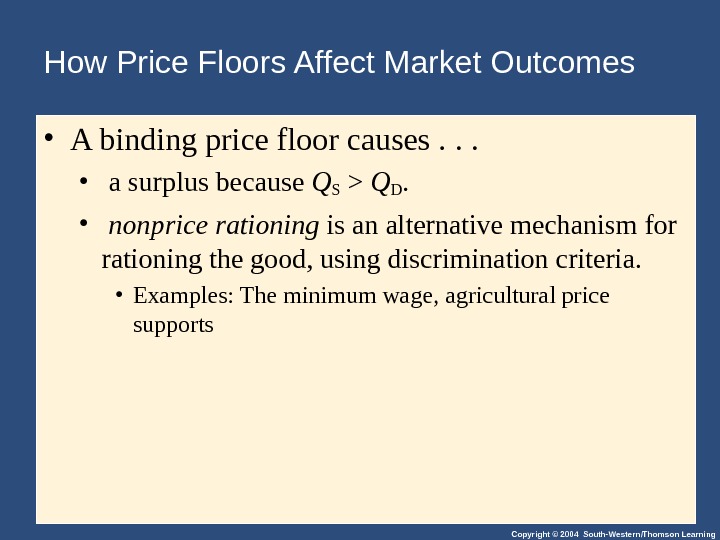
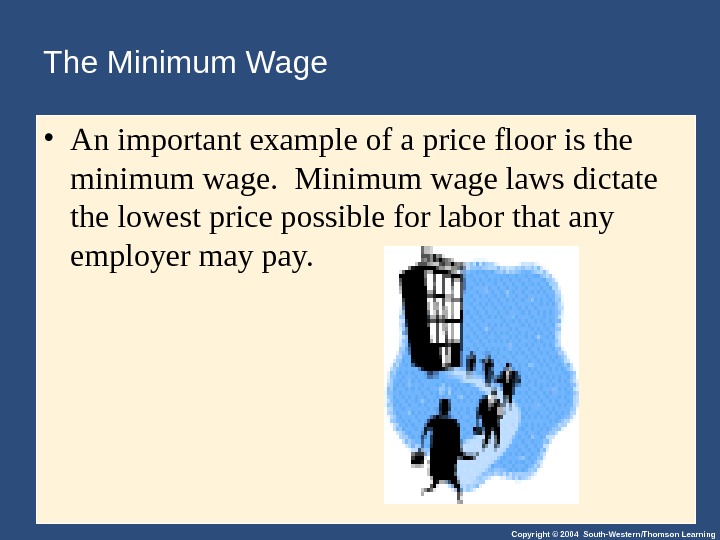
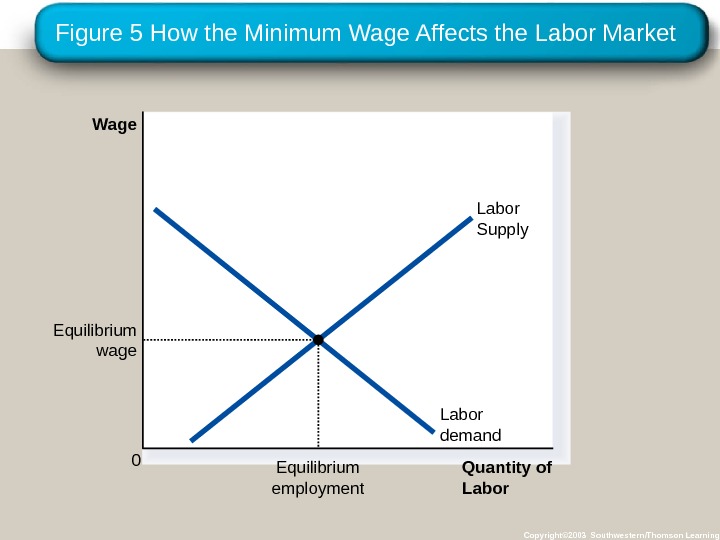

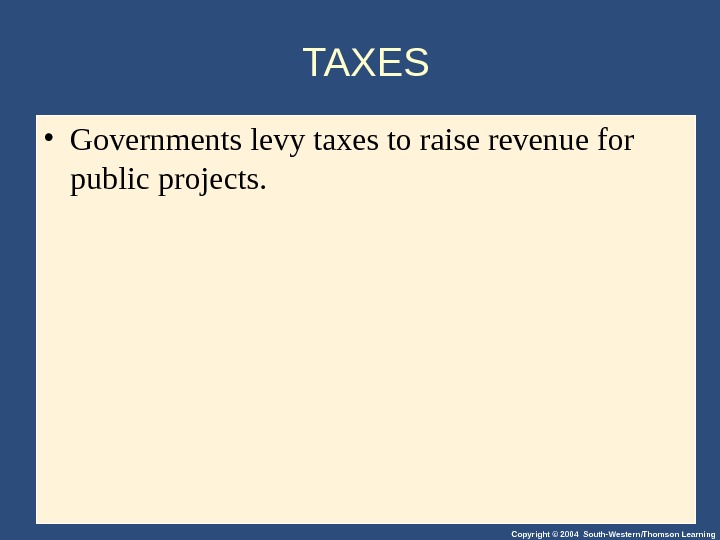
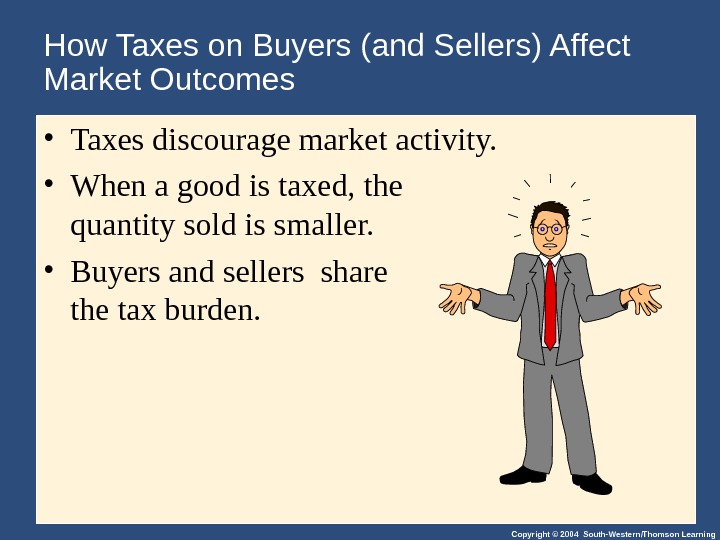
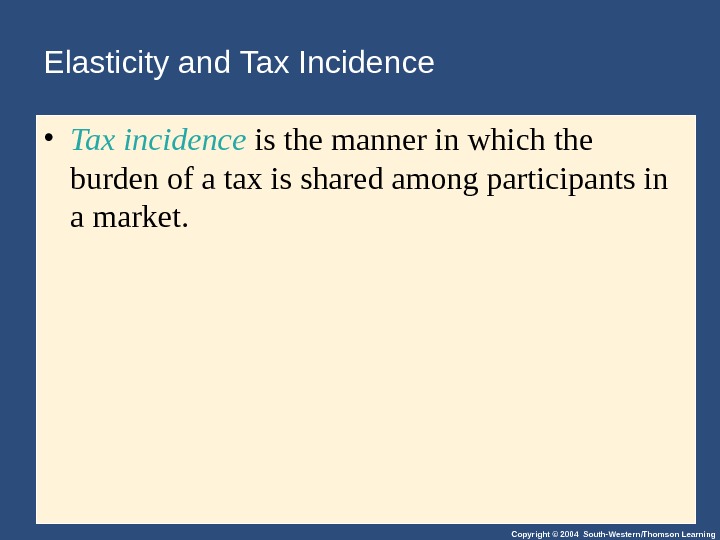

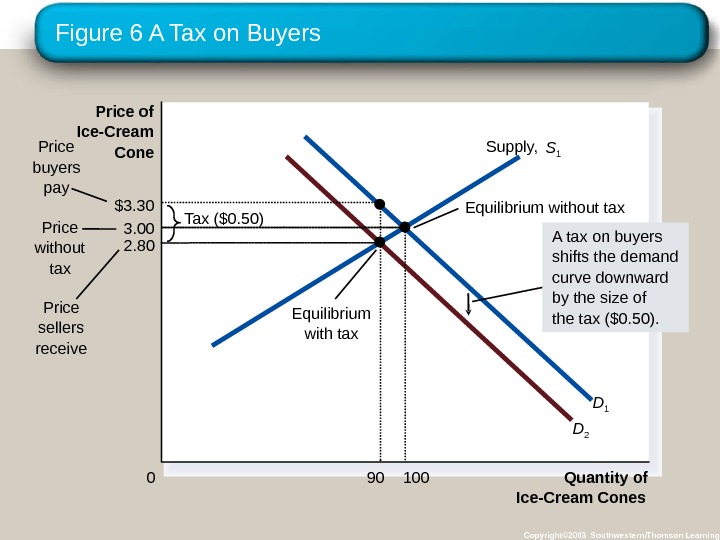

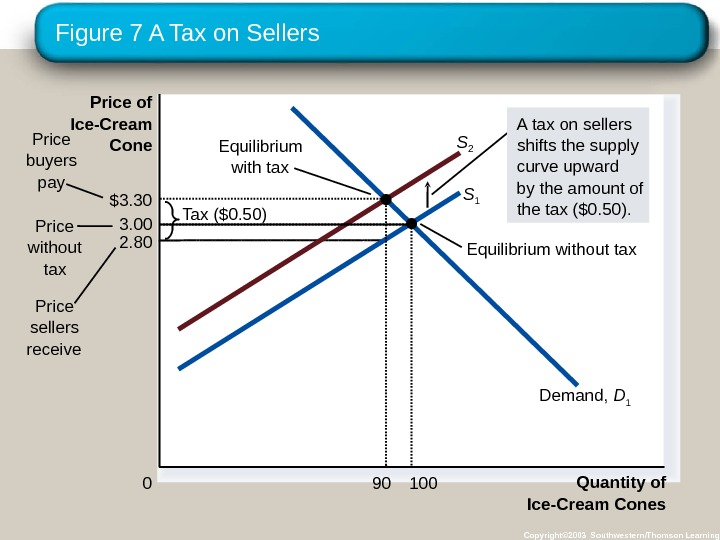
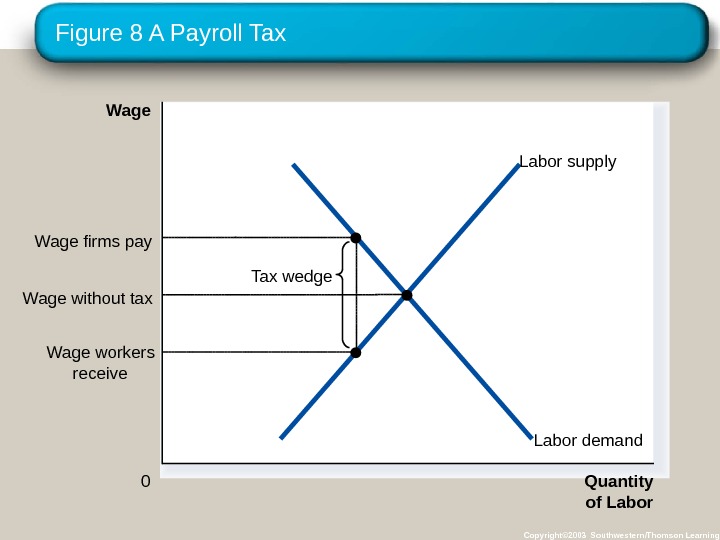
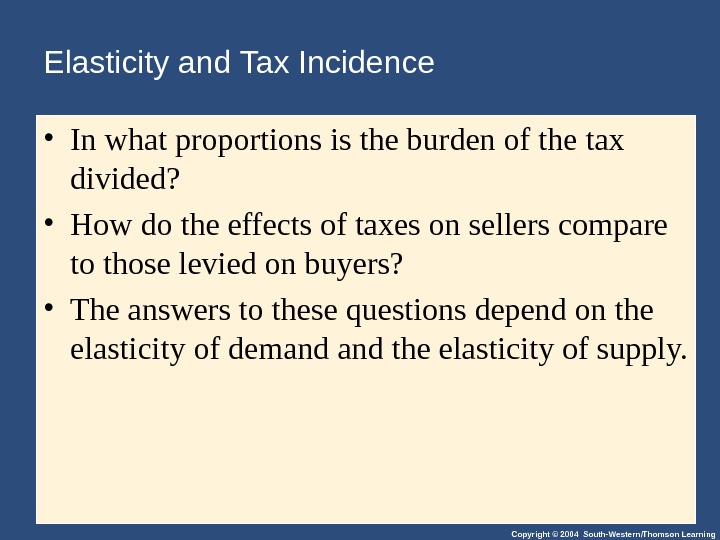
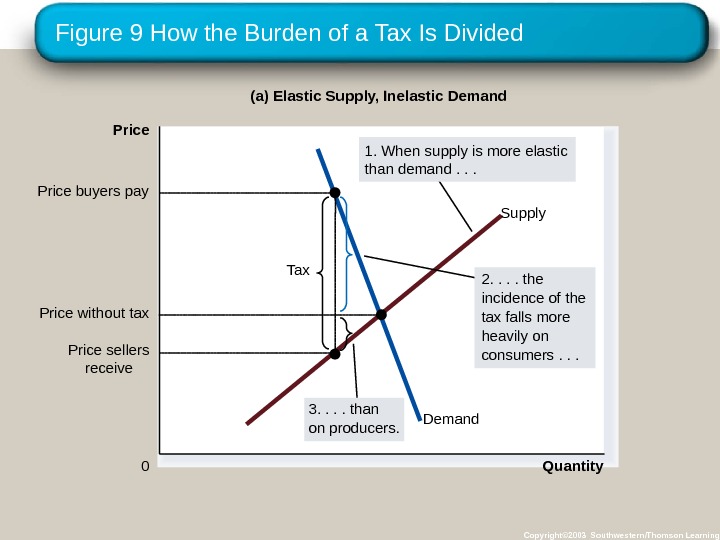




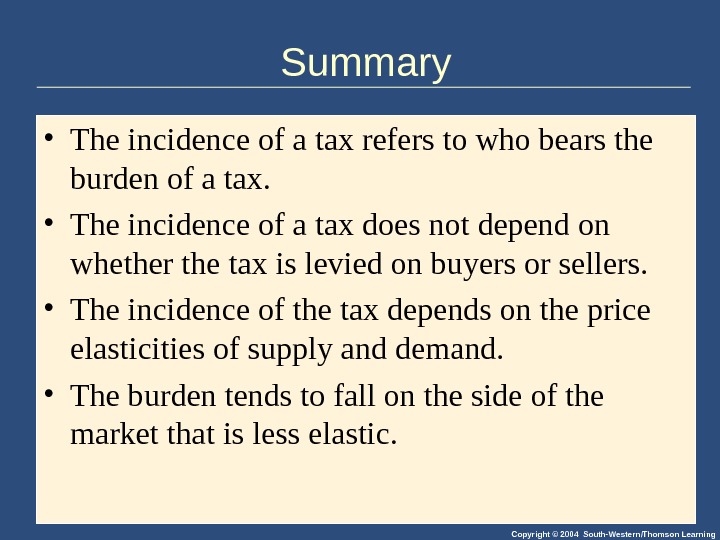
session2_supply_and_demand_govt_and_taxes.ppt
- Размер: 1.3 Mегабайта
- Количество слайдов: 37
Описание презентации Copyright © 2004 South-Western 66 Supply, Demand, and по слайдам
 Copyright © 2004 South-Western 66 Supply, Demand, and Government Policies
Copyright © 2004 South-Western 66 Supply, Demand, and Government Policies
 Copyright © 2004 South-Western/Thomson Learning. Supply, Demand, and Government Policies • In a free, unregulated market system, market forces establish equilibrium prices and exchange quantities. • While equilibrium conditions may be efficient, it may be true that not everyone is satisfied. • One of the roles of economists is to use their theories to assist in the development of policies.
Copyright © 2004 South-Western/Thomson Learning. Supply, Demand, and Government Policies • In a free, unregulated market system, market forces establish equilibrium prices and exchange quantities. • While equilibrium conditions may be efficient, it may be true that not everyone is satisfied. • One of the roles of economists is to use their theories to assist in the development of policies.
 Copyright © 2004 South-Western/Thomson Learning. CONTROLS ON PRICES • Are usually enacted when policymakers believe the market price is unfair to buyers or sellers. • Result in government-created price ceilings and floors.
Copyright © 2004 South-Western/Thomson Learning. CONTROLS ON PRICES • Are usually enacted when policymakers believe the market price is unfair to buyers or sellers. • Result in government-created price ceilings and floors.
 Copyright © 2004 South-Western/Thomson Learning. CONTROLS ON PRICES • Price Ceiling • A legal maximum on the price at which a good can be sold. • Price Floor • A legal minimum on the price at which a good can be sold.
Copyright © 2004 South-Western/Thomson Learning. CONTROLS ON PRICES • Price Ceiling • A legal maximum on the price at which a good can be sold. • Price Floor • A legal minimum on the price at which a good can be sold.
 Copyright © 2004 South-Western/Thomson Learning. How Price Ceilings Affect Market Outcomes • Two outcomes are possible when the government imposes a price ceiling: • The price ceiling is not binding if set above the equilibrium price. • The price ceiling is binding if set below the equilibrium price, leading to a shortage.
Copyright © 2004 South-Western/Thomson Learning. How Price Ceilings Affect Market Outcomes • Two outcomes are possible when the government imposes a price ceiling: • The price ceiling is not binding if set above the equilibrium price. • The price ceiling is binding if set below the equilibrium price, leading to a shortage.
 Figure 1 A Market with a Price Ceiling (a) A Price Ceiling That Is Not Binding Quantity of Ice-Cream Cones 0 Price of Ice-Cream Cone Equilibrium quantity$4 Price ceiling Equilibrium price Demand. Supply
Figure 1 A Market with a Price Ceiling (a) A Price Ceiling That Is Not Binding Quantity of Ice-Cream Cones 0 Price of Ice-Cream Cone Equilibrium quantity$4 Price ceiling Equilibrium price Demand. Supply
 Figure 1 A Market with a Price Ceiling Copyright© 2003 Southwestern/Thomson Learning(b) A Price Ceiling That Is Binding Quantity of Ice-Cream Cones 0 Price of Ice-Cream Cone Demand. Supply 2 Price ceiling Shortage 75 Quantity supplied 125 Quantity demanded. Equilibrium price $
Figure 1 A Market with a Price Ceiling Copyright© 2003 Southwestern/Thomson Learning(b) A Price Ceiling That Is Binding Quantity of Ice-Cream Cones 0 Price of Ice-Cream Cone Demand. Supply 2 Price ceiling Shortage 75 Quantity supplied 125 Quantity demanded. Equilibrium price $
 Copyright © 2004 South-Western/Thomson Learning. How Price Ceilings Affect Market Outcomes • Effects of Price Ceilings • A binding price ceiling creates • shortages because QD > QS. • Example: Gasoline shortage of the 1970 s • nonprice rationing • Examples: Long lines, discrimination by sellers
Copyright © 2004 South-Western/Thomson Learning. How Price Ceilings Affect Market Outcomes • Effects of Price Ceilings • A binding price ceiling creates • shortages because QD > QS. • Example: Gasoline shortage of the 1970 s • nonprice rationing • Examples: Long lines, discrimination by sellers
 Copyright © 2004 South-Western/Thomson Learning • In 1973, OPEC raised the price of crude oil in world markets. Crude oil is the major input in gasoline, so the higher oil prices reduced the supply of gasoline. • What was responsible for the long gas lines? CASE STUDY: Lines at the Gas Pump • Economists blame government regulations that limited the price oil companies could charge for gasoline.
Copyright © 2004 South-Western/Thomson Learning • In 1973, OPEC raised the price of crude oil in world markets. Crude oil is the major input in gasoline, so the higher oil prices reduced the supply of gasoline. • What was responsible for the long gas lines? CASE STUDY: Lines at the Gas Pump • Economists blame government regulations that limited the price oil companies could charge for gasoline.
 Figure 2 The Market for Gasoline with a Price Ceiling Copyright© 2003 Southwestern/Thomson Learning(a) The Price Ceiling on Gasoline Is Not Binding Quantity of Gasoline 0 Price of Gasoline 1. Initially, the price ceiling is not binding. . . Price ceiling Demand Supply, S 1 P 1 Q
Figure 2 The Market for Gasoline with a Price Ceiling Copyright© 2003 Southwestern/Thomson Learning(a) The Price Ceiling on Gasoline Is Not Binding Quantity of Gasoline 0 Price of Gasoline 1. Initially, the price ceiling is not binding. . . Price ceiling Demand Supply, S 1 P 1 Q
 Figure 2 The Market for Gasoline with a Price Ceiling Copyright© 2003 Southwestern/Thomson Learning(b) The Price Ceiling on Gasoline Is Binding Quantity of Gasoline 0 Price of Gasoline Demand S 1 S 2 Price ceiling Q S 4. . resulting in a shortage. 3. . the price ceiling becomes binding. . . 2. . but when supply falls. . . P 2 Q DP 1 Q
Figure 2 The Market for Gasoline with a Price Ceiling Copyright© 2003 Southwestern/Thomson Learning(b) The Price Ceiling on Gasoline Is Binding Quantity of Gasoline 0 Price of Gasoline Demand S 1 S 2 Price ceiling Q S 4. . resulting in a shortage. 3. . the price ceiling becomes binding. . . 2. . but when supply falls. . . P 2 Q DP 1 Q
 Copyright © 2004 South-Western/Thomson Learning. CASE STUDY: Rent Control in the Short Run and Long Run • Rent controls are ceilings placed on the rents that landlords may charge their tenants. • The goal of rent control policy is to help the poor by making housing more affordable. • One economist called rent control “the best way to destroy a city, other than bombing. ”
Copyright © 2004 South-Western/Thomson Learning. CASE STUDY: Rent Control in the Short Run and Long Run • Rent controls are ceilings placed on the rents that landlords may charge their tenants. • The goal of rent control policy is to help the poor by making housing more affordable. • One economist called rent control “the best way to destroy a city, other than bombing. ”
 Figure 3 Rent Control in the Short Run and in the Long Run Copyright© 2003 Southwestern/Thomson Learning(a) Rent Control in the Short Run (supply and demand are inelastic) Quantity of Apartments 0 Supply Controlled rent. Rental Price of Apartment Demand. Shortage
Figure 3 Rent Control in the Short Run and in the Long Run Copyright© 2003 Southwestern/Thomson Learning(a) Rent Control in the Short Run (supply and demand are inelastic) Quantity of Apartments 0 Supply Controlled rent. Rental Price of Apartment Demand. Shortage
 Figure 3 Rent Control in the Short Run and in the Long Run Copyright© 2003 Southwestern/Thomson Learning(b) Rent Control in the Long Run (supply and demand are elastic) 0 Rental Price of Apartment Quantity of Apartments Demand Supply Controlled rent Shortage
Figure 3 Rent Control in the Short Run and in the Long Run Copyright© 2003 Southwestern/Thomson Learning(b) Rent Control in the Long Run (supply and demand are elastic) 0 Rental Price of Apartment Quantity of Apartments Demand Supply Controlled rent Shortage
 Copyright © 2004 South-Western/Thomson Learning. How Price Floors Affect Market Outcomes • When the government imposes a price floor, two outcomes are possible. • The price floor is not binding if set below the equilibrium price. • The price floor is binding if set above the equilibrium price, leading to a surplus.
Copyright © 2004 South-Western/Thomson Learning. How Price Floors Affect Market Outcomes • When the government imposes a price floor, two outcomes are possible. • The price floor is not binding if set below the equilibrium price. • The price floor is binding if set above the equilibrium price, leading to a surplus.
 Figure 4 A Market with a Price Floor Copyright© 2003 Southwestern/Thomson Learning(a) A Price Floor That Is Not Binding Quantity of Ice-Cream Cones 0 Price of Ice-Cream Cone Equilibrium quantity 2 Price floor. Equilibrium price Demand. Supply $
Figure 4 A Market with a Price Floor Copyright© 2003 Southwestern/Thomson Learning(a) A Price Floor That Is Not Binding Quantity of Ice-Cream Cones 0 Price of Ice-Cream Cone Equilibrium quantity 2 Price floor. Equilibrium price Demand. Supply $
 Figure 4 A Market with a Price Floor Copyright© 2003 Southwestern/Thomson Learning(b) A Price Floor That Is Binding Quantity of Ice-Cream Cones 0 Price of Ice-Cream Cone Demand. Supply $4 Price floor 80 Quantity demanded 120 Quantity supplied. Equilibrium price Surplus
Figure 4 A Market with a Price Floor Copyright© 2003 Southwestern/Thomson Learning(b) A Price Floor That Is Binding Quantity of Ice-Cream Cones 0 Price of Ice-Cream Cone Demand. Supply $4 Price floor 80 Quantity demanded 120 Quantity supplied. Equilibrium price Surplus
 Copyright © 2004 South-Western/Thomson Learning. How Price Floors Affect Market Outcomes • A price floor prevents supply and demand from moving toward the equilibrium price and quantity. • When the market price hits the floor, it can fall no further, and the market price equals the floor price.
Copyright © 2004 South-Western/Thomson Learning. How Price Floors Affect Market Outcomes • A price floor prevents supply and demand from moving toward the equilibrium price and quantity. • When the market price hits the floor, it can fall no further, and the market price equals the floor price.
 Copyright © 2004 South-Western/Thomson Learning. How Price Floors Affect Market Outcomes • A binding price floor causes. . . • a surplus because QS > QD. • nonprice rationing is an alternative mechanism for rationing the good, using discrimination criteria. • Examples: The minimum wage, agricultural price supports
Copyright © 2004 South-Western/Thomson Learning. How Price Floors Affect Market Outcomes • A binding price floor causes. . . • a surplus because QS > QD. • nonprice rationing is an alternative mechanism for rationing the good, using discrimination criteria. • Examples: The minimum wage, agricultural price supports
 Copyright © 2004 South-Western/Thomson Learning. The Minimum Wage • An important example of a price floor is the minimum wage. Minimum wage laws dictate the lowest price possible for labor that any employer may pay.
Copyright © 2004 South-Western/Thomson Learning. The Minimum Wage • An important example of a price floor is the minimum wage. Minimum wage laws dictate the lowest price possible for labor that any employer may pay.
 Figure 5 How the Minimum Wage Affects the Labor Market Copyright© 2003 Southwestern/Thomson Learning. Quantity of Labor. Wage 0 Labor demand Labor Supply Equilibrium employment. Equilibrium wage
Figure 5 How the Minimum Wage Affects the Labor Market Copyright© 2003 Southwestern/Thomson Learning. Quantity of Labor. Wage 0 Labor demand Labor Supply Equilibrium employment. Equilibrium wage
 Figure 5 How the Minimum Wage Affects the Labor Market Copyright© 2003 Southwestern/Thomson Learning. Quantity of Labor. Wage 0 Labor Supply Labor surplus (unemployment) Labor demand. Minimum wage Quantity demanded Quantity supplied
Figure 5 How the Minimum Wage Affects the Labor Market Copyright© 2003 Southwestern/Thomson Learning. Quantity of Labor. Wage 0 Labor Supply Labor surplus (unemployment) Labor demand. Minimum wage Quantity demanded Quantity supplied
 Copyright © 2004 South-Western/Thomson Learning. TAXES • Governments levy taxes to raise revenue for public projects.
Copyright © 2004 South-Western/Thomson Learning. TAXES • Governments levy taxes to raise revenue for public projects.
 Copyright © 2004 South-Western/Thomson Learning. How Taxes on Buyers (and Sellers) Affect Market Outcomes • Taxes discourage market activity. • When a good is taxed, the quantity sold is smaller. • Buyers and sellers share the tax burden.
Copyright © 2004 South-Western/Thomson Learning. How Taxes on Buyers (and Sellers) Affect Market Outcomes • Taxes discourage market activity. • When a good is taxed, the quantity sold is smaller. • Buyers and sellers share the tax burden.
 Copyright © 2004 South-Western/Thomson Learning. Elasticity and Tax Incidence • Tax incidence is the manner in which the burden of a tax is shared among participants in a market.
Copyright © 2004 South-Western/Thomson Learning. Elasticity and Tax Incidence • Tax incidence is the manner in which the burden of a tax is shared among participants in a market.
 Copyright © 2004 South-Western/Thomson Learning. Elasticity and Tax Incidence • Tax incidence is the study of who bears the burden of a tax. • Taxes result in a change in market equilibrium. • Buyers pay more and sellers receive less, regardless of whom the tax is levied on.
Copyright © 2004 South-Western/Thomson Learning. Elasticity and Tax Incidence • Tax incidence is the study of who bears the burden of a tax. • Taxes result in a change in market equilibrium. • Buyers pay more and sellers receive less, regardless of whom the tax is levied on.
 Figure 6 A Tax on Buyers Copyright© 2003 Southwestern/Thomson Learning Quantity of Ice-Cream Cones 0 Price of Ice-Cream Cone Price without tax Price sellers receive Equilibrium without tax Tax ($0. 50)Price buyers pay D 1 D 2 Supply, S 1 A tax on buyers shifts the demand curve downward by the size of the tax ($0. 50). $3. 30 90 Equilibrium with tax 2. 803.
Figure 6 A Tax on Buyers Copyright© 2003 Southwestern/Thomson Learning Quantity of Ice-Cream Cones 0 Price of Ice-Cream Cone Price without tax Price sellers receive Equilibrium without tax Tax ($0. 50)Price buyers pay D 1 D 2 Supply, S 1 A tax on buyers shifts the demand curve downward by the size of the tax ($0. 50). $3. 30 90 Equilibrium with tax 2. 803.
 Copyright © 2004 South-Western/Thomson Learning. Elasticity and Tax Incidence • What was the impact of tax? • Taxes discourage market activity. • When a good is taxed, the quantity sold is smaller. • Buyers and sellers share the tax burden.
Copyright © 2004 South-Western/Thomson Learning. Elasticity and Tax Incidence • What was the impact of tax? • Taxes discourage market activity. • When a good is taxed, the quantity sold is smaller. • Buyers and sellers share the tax burden.
 Figure 7 A Tax on Sellers Copyright© 2003 Southwestern/Thomson Learning 2. 80 Quantity of Ice-Cream Cones 0 Price of Ice-Cream Cone Price without tax Price sellers receive Equilibrium with tax Equilibrium without tax. Tax ($0. 50)Price buyers pay S 1 S 2 Demand, D 1 A tax on sellers shifts the supply curve upward by the amount of the tax ($0. 50). 3. 00 100$3.
Figure 7 A Tax on Sellers Copyright© 2003 Southwestern/Thomson Learning 2. 80 Quantity of Ice-Cream Cones 0 Price of Ice-Cream Cone Price without tax Price sellers receive Equilibrium with tax Equilibrium without tax. Tax ($0. 50)Price buyers pay S 1 S 2 Demand, D 1 A tax on sellers shifts the supply curve upward by the amount of the tax ($0. 50). 3. 00 100$3.
 Figure 8 A Payroll Tax Copyright© 2003 Southwestern/Thomson Learning Quantity of Labor 0 Wage Labor demand. Labor supply Tax wedge Wage workers receive. Wage firms pay Wage without tax
Figure 8 A Payroll Tax Copyright© 2003 Southwestern/Thomson Learning Quantity of Labor 0 Wage Labor demand. Labor supply Tax wedge Wage workers receive. Wage firms pay Wage without tax
 Copyright © 2004 South-Western/Thomson Learning. Elasticity and Tax Incidence • In what proportions is the burden of the tax divided? • How do the effects of taxes on sellers compare to those levied on buyers? • The answers to these questions depend on the elasticity of demand the elasticity of supply.
Copyright © 2004 South-Western/Thomson Learning. Elasticity and Tax Incidence • In what proportions is the burden of the tax divided? • How do the effects of taxes on sellers compare to those levied on buyers? • The answers to these questions depend on the elasticity of demand the elasticity of supply.
 Figure 9 How the Burden of a Tax Is Divided Copyright© 2003 Southwestern/Thomson Learning Quantity 0 Price Demand Supply Tax Price sellers receive. Price buyers pay (a) Elastic Supply, Inelastic Demand 2. . the incidence of the tax falls more heavily on consumers. . . 1. When supply is more elastic than demand. . . Price without tax 3. . than on producers.
Figure 9 How the Burden of a Tax Is Divided Copyright© 2003 Southwestern/Thomson Learning Quantity 0 Price Demand Supply Tax Price sellers receive. Price buyers pay (a) Elastic Supply, Inelastic Demand 2. . the incidence of the tax falls more heavily on consumers. . . 1. When supply is more elastic than demand. . . Price without tax 3. . than on producers.
 Figure 9 How the Burden of a Tax Is Divided Copyright© 2003 Southwestern/Thomson Learning Quantity 0 Price Demand. Supply Tax Price sellers receive. Price buyers pay (b) Inelastic Supply, Elastic Demand 3. . than on consumers. 1. When demand is more elastic than supply. . . Price without tax 2. . the incidence of the tax falls more heavily on producers. . .
Figure 9 How the Burden of a Tax Is Divided Copyright© 2003 Southwestern/Thomson Learning Quantity 0 Price Demand. Supply Tax Price sellers receive. Price buyers pay (b) Inelastic Supply, Elastic Demand 3. . than on consumers. 1. When demand is more elastic than supply. . . Price without tax 2. . the incidence of the tax falls more heavily on producers. . .
 Copyright © 2004 South-Western/Thomson Learning. So, how is the burden of the tax divided? • The burden of a tax falls more heavily on the side of the market that is less elastic. ELASTICITY AND TAX INCIDEN
Copyright © 2004 South-Western/Thomson Learning. So, how is the burden of the tax divided? • The burden of a tax falls more heavily on the side of the market that is less elastic. ELASTICITY AND TAX INCIDEN
 Copyright © 2004 South-Western/Thomson Learning. Summary • Price controls include price ceilings and price floors. • A price ceiling is a legal maximum on the price of a good or service. An example is rent control. • A price floor is a legal minimum on the price of a good or a service. An example is the minimum wage.
Copyright © 2004 South-Western/Thomson Learning. Summary • Price controls include price ceilings and price floors. • A price ceiling is a legal maximum on the price of a good or service. An example is rent control. • A price floor is a legal minimum on the price of a good or a service. An example is the minimum wage.
 Copyright © 2004 South-Western/Thomson Learning. Summary • Taxes are used to raise revenue for public purposes. • When the government levies a tax on a good, the equilibrium quantity of the good falls. • A tax on a good places a wedge between the price paid by buyers and the price received by sellers.
Copyright © 2004 South-Western/Thomson Learning. Summary • Taxes are used to raise revenue for public purposes. • When the government levies a tax on a good, the equilibrium quantity of the good falls. • A tax on a good places a wedge between the price paid by buyers and the price received by sellers.
 Copyright © 2004 South-Western/Thomson Learning. Summary • The incidence of a tax refers to who bears the burden of a tax. • The incidence of a tax does not depend on whether the tax is levied on buyers or sellers. • The incidence of the tax depends on the price elasticities of supply and demand. • The burden tends to fall on the side of the market that is less elastic.
Copyright © 2004 South-Western/Thomson Learning. Summary • The incidence of a tax refers to who bears the burden of a tax. • The incidence of a tax does not depend on whether the tax is levied on buyers or sellers. • The incidence of the tax depends on the price elasticities of supply and demand. • The burden tends to fall on the side of the market that is less elastic.
